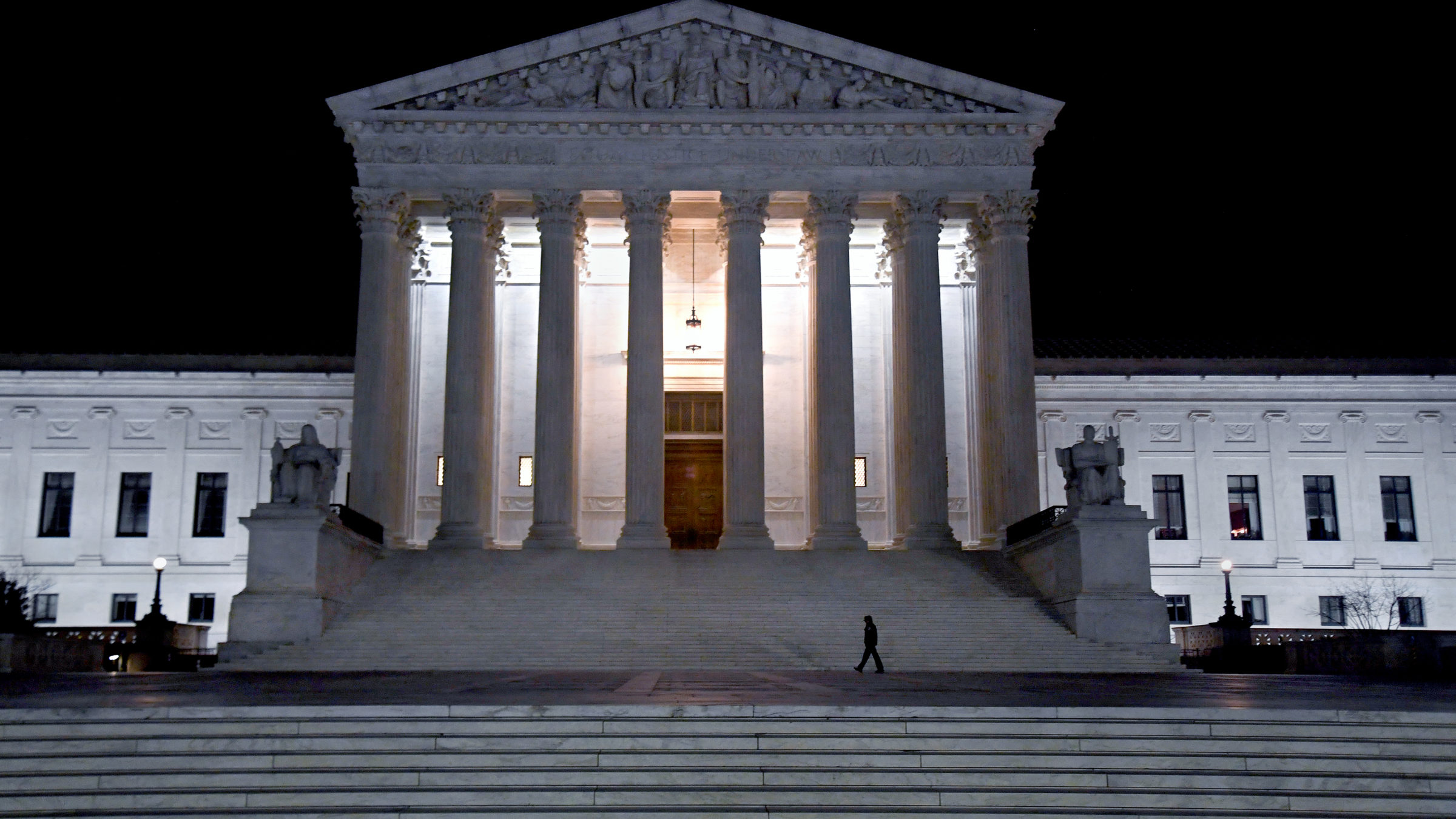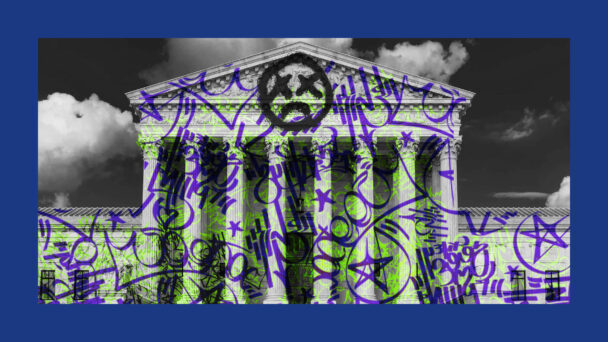Institutionally, the Supreme Court and the police share a special bond. Though I’m sure Samuel Alito would absolutely love to hang “thin blue line” flags all over the joint, the Court doesn’t need the decor and bumper stickers to prove its pro-police bona fides. It does so through its jurisprudence. In many respects, today’s 6-3 conservative supermajority doesn’t even have to do the police’s legal dirty work. A case from the early 1980s shows that the Court has spent generations shaping a system in which holding cops accountable is functionally impossible. In City of Los Angeles v. Lyons, a case about police chokeholds, the conservative legal movement was building the foundation for the massive structural obstacles to suing the police—obstacles that persist to this day.
In October 1976, Adolph Lyons, a 24-year-old Black man, was stopped by four white LAPD officers for driving with a broken tail light. There was no evidence that Lyons disobeyed police orders or threatened the officers. Even so, the cops ordered him out of the car and approached him with their guns drawn. They told Lyons to face his car, put his hands above his head, and spread his legs. When Lyons lowered his hands for a moment, one officer put him in a chokehold until Lyons lost consciousness. When he woke up, he was on the ground facedown, his mouth was full of blood and dirt, and he had soiled himself.
In February 1977, Lyons filed a lawsuit against the City of Los Angeles asking for an injunction to ban LAPD officers from using chokeholds when there was no threat of injury or death to an officer. Lyons was saying, essentially, that he feared he would be placed in another chokehold in the future by unprovoked LAPD officers, that other people are routinely placed in these chokeholds and have been similarly severely injured or even killed as a result, and he was asking the court to make LAPD stop.
The federal district court found in Lyons’ favor in a ruling that was not kind to the LAPD. The court found that LAPD regularly authorized the use of chokeholds in situations where no officer was threatened; that LAPD officers were insufficiently trained on the use of chokeholds and bodily force; that the use of chokeholds carried a high risk of injury or death; and that the continued use of chokeholds in this way “is unconscionable in a civilized society.” Between 1975 and 1980, LAPD officers had used chokeholds nearly 1,000 times. By the time the City’s appeal made it to the Supreme Court, Lyons had collected data showing that between 1975 and 1982, sixteen people—twelve of them Black men—had been killed by LAPD chokeholds. These officers weren’t just bringing a gun to a knife fight. They were bringing a gun AND a potentially lethal chokehold to a fight they had just started, against someone who was just trying to make it through a police encounter without dying.
At the Supreme Court, though, it was time for five unelected law wizards to wave their gavel wands to make Adolph Lyons’s request for injunctive relief disappear. This was 1983, just fifteen years after the Civil Rights Movement, and the court was frothing at the mouth to undo recent progress. Writing for a 5-4 majority, Justice Byron White set a new rule for plaintiffs seeking injunctions: They had to show a “realistic threat” in the future of being harmed in the same way, and a “sufficient likelihood” that their constitutional rights will be similarly violated again. Even though “there will be certain instances in which strangleholds will be illegally applied and injury and death inflicted on the victim,” White acknowledged, the Court suddenly required a facially impossible burden of plaintiffs—a concrete showing that in the future the police will act in the same way again, on an indiscriminate and widespread basis.

Home of unelected law wizards (Photo by Michael S. Williamson/The Washington Post via Getty Images)
Think about how dumb this is. Lyons had already been unconstitutionally strangled once, and LAPD had strangled literally hundreds of people in the years since, some of whom died as a result. Everyone involved in this case, including the justices, surely knew that chokeholds would of course continue to be used by police. Even so, our unelected judicial magicians are issuing the jurisprudential equivalent of “YOU SHALL NOT PASS.” Out of thin air, they invented a massive legal burden to protect cops’ right to place people in life-threatening chokeholds for no reason other than “we feel like it.”
The language the Court uses to explain its reasoning characterizes this burden as literally extraordinary: in order to sue for an injunction, “Lyons would have had not only to allege that he would have another encounter with the police,” but would also have to “make the incredible assertion that all police officers in Los Angeles always choke any citizen with whom they happen to have an encounter,” or that the City authorized police officers to choke any citizen in any encounter. These are not words I am using to explain the standard the Court is setting here–these are direct quotes from the opinion, in which the majority describes their own standard as impossible to meet.
All police officers, in every instance? A plaintiff has to show that LAPD officers choke out every single person they interact with for a court to be able to tell them to stop? This is nonsensical. Justice Thurgood Marshall was clearly frustrated by these disturbingly unrealistic rules in his dissent. “Since no one can show that he will be choked in the future, no one—not even a person who, like Lyons, has almost been choked to death—has standing to challenge the continuation of the policy,” Marshall wrote. In fashioning a ridiculously high burden for plaintiffs seeking injunctive relief, the majority decision exposes the policy preferences and biases of the Court with regard to police, and its activism in service of conservative ideology.
The Lyons decision is an egregious example of conservative judicial activism on procedural grounds. Here, the Court throws out a lawsuit before it even reaches the substantive merits of the claim–whether or not LAPD’s use of chokeholds was unconstitutional. As Marshall said in dissent, “[t]he Court today holds that a federal court is without power to enjoin the enforcement of the city’s policy, no matter how flagrantly unconstitutional it may be.” Lacking any substantive basis for saying that it was constitutionally permissible, actually, that 75 percent of chokehold deaths had happened to Black men in a city in which Black men made up 9 percent of the population, the conservative majority turned to remaking legal procedure requirements to conclude that a plaintiff has to show that the unconstitutional behavior would extend, in the future, to all police encounters in order to even ask for an injunction.
One wonders how many police chokehold injuries and deaths would have been prevented in the wake of Lyons had a single justice decided the other way. Instead, the Court abdicated the judiciary’s responsibility to conceive of forward-looking remedies—its power to protect people from future harm. The Court hides its failure under a hypertechnical discussion of procedural rules—a formalistic prioritization of rules for rules’ sake. But procedural rules evince moral and political values, just like substantive rules. And when the rule results in no one being able to challenge an unconstitutional police practice, it reveals a foundational value in conservative ideology: the creation of a formalistic, rigid, and insurmountable procedural jurisprudence is a cover for allowing police brutality.
How many plaintiffs seeking injunctive relief against the police have been kept out of court in the 40 years since Lyons was decided? A victim’s ability to collect money damages from police is already limited by doctrines like qualified immunity. After Lyons, which effectively bars injunctive remedies, all that’s left is a jurisprudence of police impunity. The Supreme Court played a central role in creating this reality. Lyons is just another green light for the police to keep harming the people they claim to protect.




